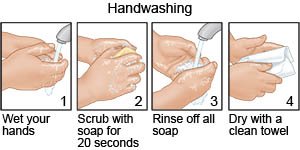How to Flush your Midline Catheter
Medically reviewed by Drugs.com. Last updated on Apr 6, 2025.
Your healthcare provider will tell you how often to flush your catheter. He or she will also tell you how much saline to use to flush the catheter. Your provider will also tell you if you also need to use heparin. Always flush your catheter before and after you get medicine through it. If you have more than one port, you will need to flush each port.
DISCHARGE INSTRUCTIONS:
Call your local emergency number (911 in the US) for any of the following:
- You feel lightheaded, short of breath, or have chest pain.
- You have trouble breathing.
- You cough up blood.
Return to the emergency department if:
- Blood soaks through your bandage.
- Your arm or leg feels warm, tender, and painful. It may look swollen and red.
- You have trouble moving your arm.
- Your catheter falls out.
Call your doctor if:
- You have a fever or swelling, redness, pain, or pus where the catheter was inserted.
- You cannot flush your catheter, or you feel pain when you flush your catheter.
- You see a tear in the tubing of your catheter.
- You see fluid leaking from the insertion site.
- You have questions or concerns about your condition or care.
How to flush your midline catheter:
Always flush with saline first, if you also use heparin.
- Place your supplies on a clean surface. Supplies include the syringe of saline and cleaning pads. Heparin syringes will be given to you, if needed. Keep the pads in their wrappers until you are ready to use them.
- Wash your hands for 30 seconds. Use soap and water or an alcohol-based hand rub. Then put on a pair of clean medical gloves.

- Open a cleaning pad. Scrub the injection cap with the pad for 15 to 30 seconds. Put the pad around the cap, not over it. Use a twisting motion to clean the cap. After you clean the cap, do not touch it or let it touch anything. You will need to clean it again if you accidentally touch it or let it touch something else. Let the cap air dry. Do not blow on the cap to make it dry faster.
- Take the syringe out of the plastic wrapper. Remove the cap from the syringe. Push the plunger until a little liquid comes out. This will remove any air bubbles.
- Push the syringe onto the injection cap. Turn the syringe to lock it in place. Open the clamp if your catheter has one.
- Slowly push on the plunger of the syringe to flush your catheter. Use several short pushes. Stop if it is difficult to push the plunger. Do not force the saline or heparin into your catheter. This could damage the catheter or your vein. The force could also cause a blood clot to move into your blood. Stop when about 1 milliliter (mL) is left in the syringe. This will keep any air bubbles in the syringe.
- Remove the syringe and throw it away. Scrub the injection cap with an alcohol pad for 15 to 30 seconds. Put your catheter line back in place on your arm. Wash your hands again.
Follow up with your doctor as directed:
Write down your questions so you remember to ask them during your visits.
© Copyright Merative 2025 Information is for End User's use only and may not be sold, redistributed or otherwise used for commercial purposes.
The above information is an educational aid only. It is not intended as medical advice for individual conditions or treatments. Talk to your doctor, nurse or pharmacist before following any medical regimen to see if it is safe and effective for you.
Further information
Always consult your healthcare provider to ensure the information displayed on this page applies to your personal circumstances.
